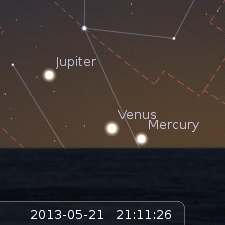¡SkyCaramba! Astronomy blog for the week ending May 25, 2013
Three planets meet up
 In the next few nights, three planets that haven’t met up in two years are coming together in the evening sky. On May 21, Mercury will be just below Venus which will be below Jupiter. All three will be almost in a straight line. From night to night, Venus is moving upward and Mercury appears to be in hot pursuit of it.
In the next few nights, three planets that haven’t met up in two years are coming together in the evening sky. On May 21, Mercury will be just below Venus which will be below Jupiter. All three will be almost in a straight line. From night to night, Venus is moving upward and Mercury appears to be in hot pursuit of it.
On the 24th, Venus and Mercury are side by side. Then Mercury passes Venus. The three planets are in a triangle on the 26th. On the 27th, you’ll see that Mercury has passed the other two. It will continue rising above them while Venus and Jupiter get very close on the 28th.
On the 29th, the three are in nearly a straight line again. This time Mercury is above them both, Venus is second, and Jupiter is just below Venus. Jupiter drops into the sunset after that, while Mercury and Venus continue upward.
This is a convenient time to see Mercury, because easily recognizable Venus is close by. Many people have trouble recognizing Mercury when it’s not close to something else easily identified.
The last time these three planets were together was in May 2011 and Mars was with them in the morning sky. The three will be together again without Mars for three Augusts in a row: 2014, 2015, and 2016.
If you look at the three planets in our meetup this month, you’ll see Mercury in nearly full phase getting bigger every night as it comes around from the far side of the sun. It’ll be pretty much the same with Venus, although its change in size won’t be nearly as much from night to night.
A first of a kind eclipse
 If you have clear skies the night of May 24 to 25, you’ll want to try to see a special event. It’ll be the first of 71 related lunar eclipses in a Saros. Now through 3275, this eclipse will replay, getting longer and deeper. The first ones will be penumbral eclipses in which the moon passes through the outer part of Earth’s shadow. Then, there will be partial eclipses in which the moon passes partially through the inner part of Earth’s shadow. Then, there will be total eclipses followed by several centuries during which we return to having penumbral eclipses and then no eclipses at all.
If you have clear skies the night of May 24 to 25, you’ll want to try to see a special event. It’ll be the first of 71 related lunar eclipses in a Saros. Now through 3275, this eclipse will replay, getting longer and deeper. The first ones will be penumbral eclipses in which the moon passes through the outer part of Earth’s shadow. Then, there will be partial eclipses in which the moon passes partially through the inner part of Earth’s shadow. Then, there will be total eclipses followed by several centuries during which we return to having penumbral eclipses and then no eclipses at all.
The last time anyone got to see the start of a Saros for lunar eclipses was in 1984. The next time will be 2096. It will be hard. Just 1% of the moon’s surface close to the southernmost part of the lunar disk will darken or discolor just a little bit. The eclipse maximum will be at 04:10 on May 25 Universal Time. Most of the Americas and western Africa will get to see this one. So will eastern parts of the Pacific Ocean and most of the Atlantic.
¡SkyCaramba!